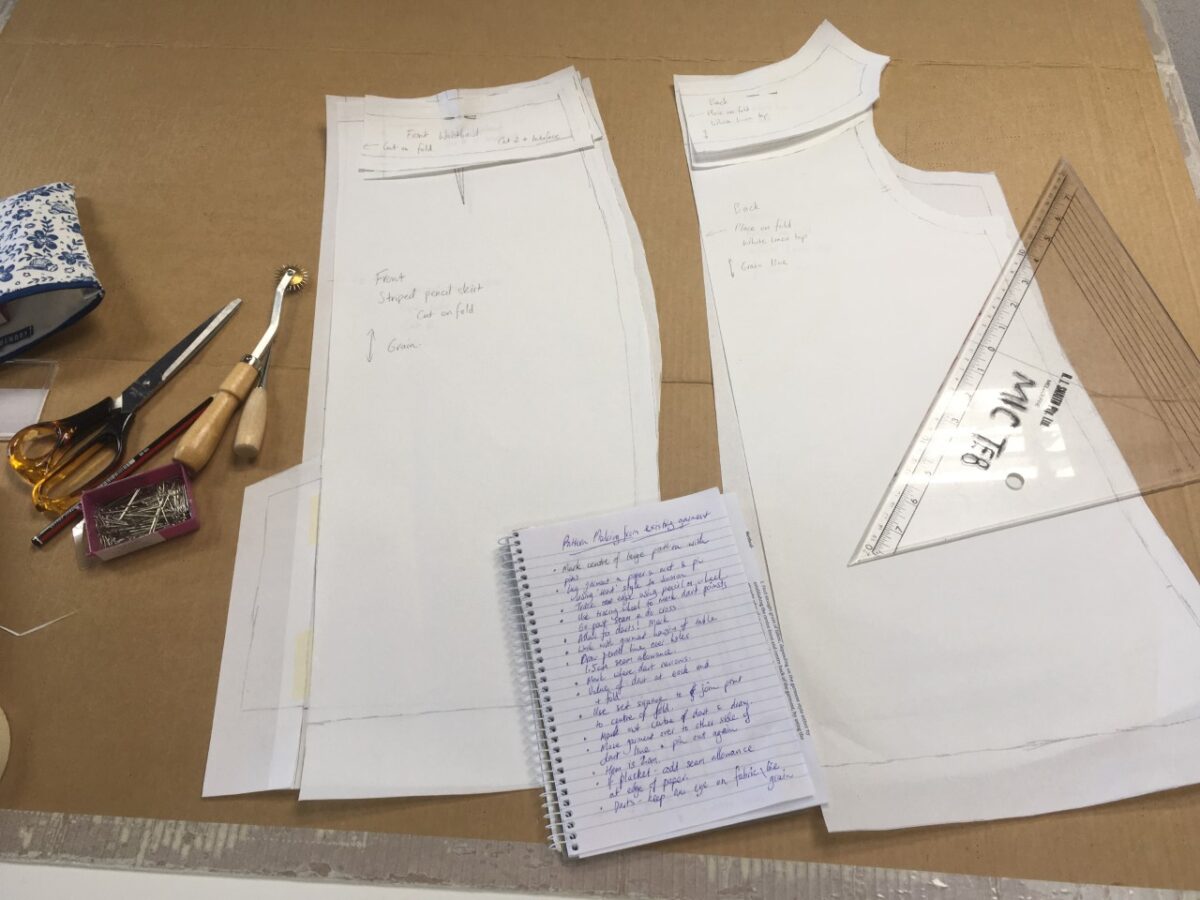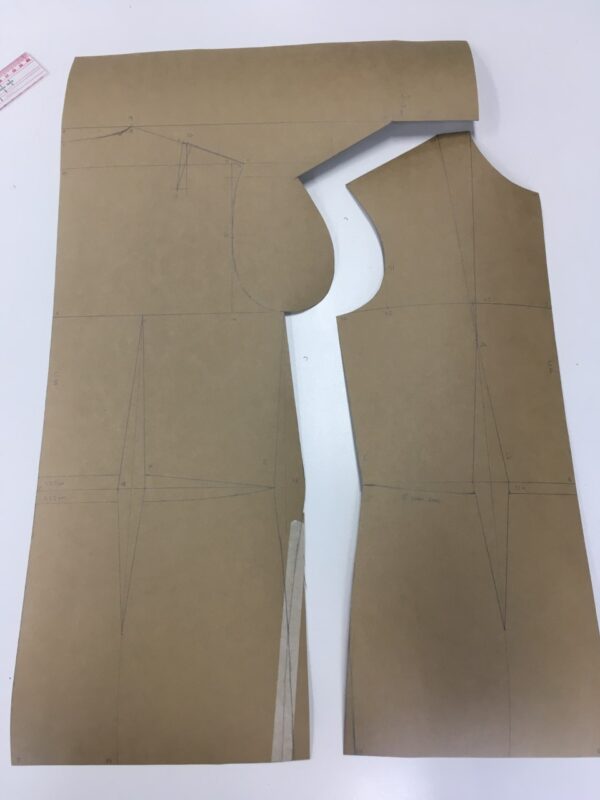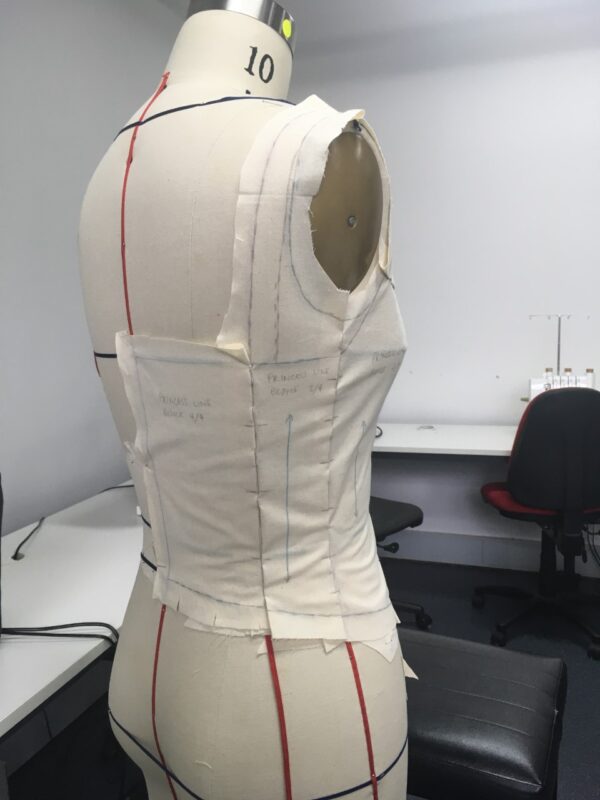Throughout 2022, I attended a suite of pattern-making courses in the Fashion, Sewing and Design department at the Centre for Adult Education (CAE) in Melbourne as a recipient of the 2021 AICCM & ADFAS Mid-career Scholarship, supported by the Australian Decorative and Fine Arts Societies (ADFAS) and the Patricia Robertson Fund.
Background
As a conservator working in the Collection Development and Access team at Museums Victoria, I am responsible for preparing objects and textile items for display, which can include mounting costume. My skills in this area are largely self-taught, with some additional knowledge gained from previously working with and learning from specialist textile conservators and mounting experts.
An important component of mounting costume for display in 3D form is the use of appropriate underpinnings. Together with mannequins, torsos, or other supports, underpinnings fulfil both aesthetic as well as preservation aims. Costume must be fully supported to prevent damage, historical accuracy is often a consideration, and even contemporary dress may require underpinnings as available mannequins and torsos are rarely the correct dimensions or shapes for garments made for real people. The mounting generally must be visually appealing and may even need to appear as if there were an animated body within. However, the skills required to manufacture underpinnings and appropriately mount costume are not readily acquired within the conservation profession.
While I was confident in selecting and modifying mannequins and torsos, making sleeve supports, constructing basic padded supports and petticoats, and am proficient in sewing, there was a gap in my ability to create underpinnings tailored to the specific measurements of each individual garment. This is where I considered that fashion-related courses could be relevant professional development for improving my skills in this area.

Stitching padded arm supports to a torso for the display of costume in ‘You Can’t Do That’ (2018). Copyright Marion Parker / All Rights Reserved. Bold, celebratory fashion exhibition You Can’t Do That opens at Melbourne Museum today – Museums Victoria
The pattern-making courses
The short courses presented by CAE provided an opportunity to learn skills related to the fashion industry, taught by experts in fashion and costume pattern design and drafting. The courses I completed were ‘Pattern-making for beginners’ taught by Jenny Moissis, which introduced a range of professional pattern-making techniques and provided an overview of creating made-to-measure garments. Another was ‘Pattern-making from an existing garment’ with Jan Bowles, which focused on teaching the skills needed to copy patterns using existing garments. ‘Draft a bodice block’ with tutor Elizabeth Maisey taught how to draft a basic bodice block and sleeve block using specific measurements. I also undertook ‘French draping’ with Karine Larché, which introduced the haute couture technique of moulage, an alternative to traditional flat pattern-making techniques that involves draping directly onto a mannequin.
Attendance at these courses resulted in learning many tips and tricks from the experienced tutors and fellow attendees, as well as the following technical skills:
- proficiency in the use of pattern-making tools and equipment, as well as standard terminology
- understanding methods for transferring fabric panels from existing garments onto paper, and techniques for copying 2D garment designs onto a 3D form
- familiarity with pattern notations including notches, fabric grain lines, title marking and seam allowance conventions, as well as cutting techniques for paper and calico patterns
- ability to use standard systems for taking body and garment measurements and applying these measurements to flat patterns
- knowledge of drafting bodice, sleeve, skirt, and trouser blocks using templates, and methods of adjusting blocks for different shapes, garment styles and dart positions
- an awareness of professional techniques for padding out torsos to suit different body shapes and sizes, and the use of tape to mark-up dress-making torsos for draping.

Paper patterns produced by copying from existing garments (2022). Copyright Charlotte Walker / All Rights Reserved.

Custom-made bodice block ready for cutting and use in pattern making (2022). Copyright Charlotte Walker / All Rights Reserved.

French draping in progress on dressmaker’s dummy (2022). Copyright Charlotte Walker / All Rights Reserved.
Review
Many of these skills will be valuable for the manufacture of underpinnings and supports, although some techniques will need adapting to be appropriate for costume mounting in a museum setting. For example, one aspect of pattern making from an existing garment involved pinning out the garment, which is not possible for collection items. Likewise, the folding of garments may not be possible to allow for copying of panels in this way.
The drafting of pattern blocks will allow for custom patterns to be made to fit both mannequins and costume. Blocks also enable the creation of accurate patterns for custom-made Dacron-padded sleeves to attach to torsos. Aspects of this method would be useful in the creation of toiles, or replicas, especially useful to avoid excessive handling of a fragile original. The technique of French draping would also be suitable for this and could be adapted to create a base for underpinnings, or as an alternative to flat pattern making when drafting designs for them.
Some of these skills have recently been put into practice in the preparation of a 1900’s style, 1980’s TV series costume going on loan to a regional historical society for display. I have used the technique of French draping to create a base on the plastic torso, and elements of copying an existing garment to create a toile of the bodice, which will be used to create bespoke underpinnings for the torso. I also plan to draft patterns for the creation of accurate padded sleeve supports. With several historical textiles being prepared for display over the coming months, I am looking forward to further refining the skills I have learnt.
Conclusion
The pattern-making courses undertaken with the support of the AICCM ADFAS Mid-career Scholarship have increased my knowledge of pattern making, thereby improving my expertise in the manufacture of underpinnings, and subsequent preservation outcomes for the safe display of costume at Museums Victoria. I would like to sincerely thank the AICCM, ADFAS, and the Patricia Robertson fund for making the scholarship possible, and Museums Victoria for supporting this professional development opportunity.